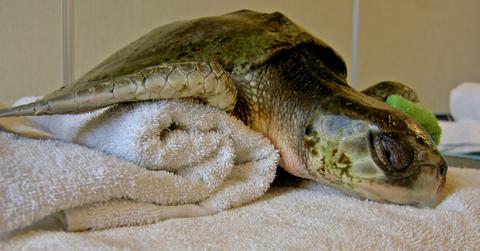Cape Cod Sea Turtles Are Currently in Recovery From Cold Stunning — What That Means
Updated Dec. 7 2020, 4:37 p.m. ET

Although the detrimental effects of global warming are blatantly visible through the Arctic's melting ice caps, planet Earth's increasingly erratic weather patterns, and through the rapidly rising sea levels, the climate crisis affects individual species differently. Large amounts of an endangered turtle species in Cape Cod called Kemp's ridley sea turtles, for example, are currently in recovery from a harmful cold stunning event, brought on by the harsh effects of climate change.
"The turtles we work with are all endangered and threatened," said Connie Merigo, NEAQ's Director of the Sea Turtle Rescue and Rehabilitation Department, as per EcoWatch. "For sea turtles in general, the future is a little grim. Climate change is real; it does impact them."

What is cold stunning? Here’s how it’s connected to climate change.
Cold stunning refers to a sometimes fatal condition sea turtles experience when overexposed to frigid waters, per Turtle Island Restoration Network. Sea turtles are ectothermic — meaning they take on the surrounding air and water temperatures — so when cold stunned, their internal body temperature plummets, preventing them from being able to swim, dive, eat, or move, making them appear dead. Oftentimes, while in this petrified state, they wash ashore to hopefully be discovered and rehabilitated.
A prolonged study of Kemp's ridley sea turtles showed that cold stunning has become an increasingly major issue in the northwestern Atlantic Ocean since the 1970s. Cold stunning is triggered by unexpected cold ocean temperatures, changing ocean currents, and varying wind patterns. Merigo told EcoWatch this season "looks very busy," noting 400 turtles had already been treated.
"It is a lot of animals. They're still coming in," she told EcoWatch after treating 39 turtles in a single day. "So far, this is a huge year."
The study used a special Bayesian count model to forecast cold stunning numbers, and it suggests that 2,300 Kemp’s ridley turtles may be cold-stunned annually by 203, as sea surface and Gulf of Maine temperatures continue rising. Yikes.

How are cold stunned turtles treated?
After hundreds of cold stunned Kemp’s ridley sea turtles were discovered off the coast of Cape Cod, many were flown to the Turtle Hospital in the Florida Keys, as per abc10. They were transported in roomy boxes by a private philanthropic group of pilots called "Turtles Fly Too," who donated planes, fuel, and their flying services to make it possible. The turtles' internal body temperatures will be warmed by 10 degrees Fahrenheit everyday, as warming them too quickly could kill them.
Some of the affected sea turtles will require additional testing, to determine if they've contracted pneumonia or other conditions from spending too much time in frigid waters, and although many of the turtles stay at the hospital for about 30 days — before being released into Florida's Atlantic waters — some may stay at the Turtle Hospital for up to one year.
While we're wishing the affected Kemp's ridley sea turtles a speedy recovery, we really hope this is one of many things that shows world leaders some major changes need to happen.